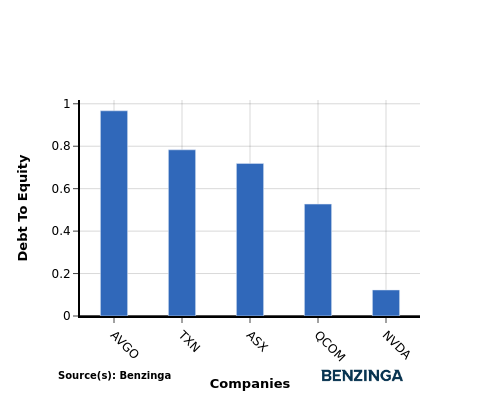Industry Comparison: Evaluating NVIDIA Against Competitors In Semiconductors & Semiconductor Equipment Industry
Amidst today's fast-paced and highly competitive business environment, it is crucial for investors and industry enthusiasts to conduct comprehensive company evaluations. In this article, we will delve into an extensive industry comparison, evaluating NVIDIA (NASDAQ:NVDA) in comparison to its major competitors within the Semiconductors & Semiconductor Equipment industry. By analyzing critical financial metrics, market position, and growth potential, our objective is to provide valuable insights for investors and offer a deeper understanding of company's performance in the industry.
NVIDIA Background
Nvidia is a leading developer of graphics processing units. Traditionally, GPUs were used to enhance the experience on computing platforms, most notably in gaming applications on PCs. GPU use cases have since emerged as important semiconductors used in artificial intelligence. Nvidia not only offers AI GPUs, but also a software platform, Cuda, used for AI model development and training. Nvidia is also expanding its data center networking solutions, helping to tie GPUs together to handle complex workloads.
| Company | P/E | P/B | P/S | ROE | EBITDA (in billions) | Gross Profit (in billions) | Revenue Growth |
|---|---|---|---|---|---|---|---|
| NVIDIA Corp | 55.62 | 50.15 | 28.71 | 23.01% | $22.58 | $26.67 | 69.18% |
| Broadcom Inc | 103.41 | 19.15 | 23.98 | 7.12% | $8.02 | $10.2 | 20.16% |
| Advanced Micro Devices Inc | 114.59 | 4.40 | 9.24 | 1.23% | $1.59 | $3.74 | 35.9% |
| Texas Instruments Inc | 41.03 | 12 | 12.40 | 7.08% | $1.85 | $2.31 | 11.14% |
| Qualcomm Inc | 15.80 | 6.13 | 4.12 | 10.3% | $3.67 | $6.04 | 16.93% |
| ARM Holdings PLC | 208.99 | 24.28 | 41.58 | 3.17% | $0.46 | $1.21 | 33.73% |
| Micron Technology Inc | 20.61 | 2.52 | 3.83 | 3.79% | $4.33 | $3.51 | 36.56% |
| Analog Devices Inc | 65.72 | 3.43 | 12.28 | 1.63% | $1.2 | $1.61 | 22.28% |
| Monolithic Power Systems Inc | 19.34 | 10.63 | 14.77 | 4.17% | $0.18 | $0.35 | 39.24% |
| STMicroelectronics NV | 27.58 | 1.64 | 2.48 | 0.32% | $0.51 | $0.84 | -27.36% |
| ON Semiconductor Corp | 42.17 | 3.16 | 3.91 | -5.78% | $-0.37 | $0.29 | -22.39% |
| ASE Technology Holding Co Ltd | 20.45 | 2.16 | 1.12 | 2.39% | $27.16 | $24.89 | 11.56% |
| First Solar Inc | 14.94 | 2.30 | 4.44 | 2.59% | $0.35 | $0.34 | 6.35% |
| United Microelectronics Corp | 11.80 | 1.42 | 2.31 | 2.06% | $23.86 | $15.45 | 5.91% |
| Credo Technology Group Holding Ltd | 322.31 | 23.54 | 38.77 | 5.63% | $0.04 | $0.11 | 179.73% |
| Skyworks Solutions Inc | 28.42 | 1.84 | 2.96 | 1.11% | $0.22 | $0.39 | -8.87% |
| Qorvo Inc | 152.71 | 2.42 | 2.27 | 0.93% | $0.11 | $0.37 | -7.6% |
| Rambus Inc | 35.71 | 6.32 | 12.25 | 5.29% | $0.08 | $0.13 | 41.4% |
| Lattice Semiconductor Corp | 143.32 | 10.30 | 15 | 0.71% | $0.02 | $0.08 | -14.68% |
| Average | 77.16 | 7.65 | 11.54 | 2.99% | $4.07 | $3.99 | 21.11% |
By closely examining NVIDIA, we can identify the following trends:
-
With a Price to Earnings ratio of 55.62, which is 0.72x less than the industry average, the stock shows potential for growth at a reasonable price, making it an interesting consideration for market participants.
-
It could be trading at a premium in relation to its book value, as indicated by its Price to Book ratio of 50.15 which exceeds the industry average by 6.56x.
-
With a relatively high Price to Sales ratio of 28.71, which is 2.49x the industry average, the stock might be considered overvalued based on sales performance.
-
The company has a higher Return on Equity (ROE) of 23.01%, which is 20.02% above the industry average. This suggests efficient use of equity to generate profits and demonstrates profitability and growth potential.
-
With higher Earnings Before Interest, Taxes, Depreciation, and Amortization (EBITDA) of $22.58 Billion, which is 5.55x above the industry average, the company demonstrates stronger profitability and robust cash flow generation.
-
The gross profit of $26.67 Billion is 6.68x above that of its industry, highlighting stronger profitability and higher earnings from its core operations.
-
The company is experiencing remarkable revenue growth, with a rate of 69.18%, outperforming the industry average of 21.11%.
Debt To Equity Ratio

The debt-to-equity (D/E) ratio helps evaluate the capital structure and financial leverage of a company.
Considering the debt-to-equity ratio in industry comparisons allows for a concise evaluation of a company's financial health and risk profile, aiding in informed decision-making.
When evaluating NVIDIA alongside its top 4 peers in terms of the Debt-to-Equity ratio, the following insights arise:
-
When comparing the debt-to-equity ratio, NVIDIA is in a stronger financial position compared to its top 4 peers.
-
The company has a lower level of debt relative to its equity, indicating a more favorable balance between the two with a lower debt-to-equity ratio of 0.12.
Key Takeaways
For NVIDIA, the PE ratio is low compared to peers, indicating potential undervaluation. The high PB and PS ratios suggest strong market sentiment and revenue multiples. In terms of ROE, EBITDA, gross profit, and revenue growth, NVIDIA outperforms industry peers, reflecting strong financial performance and growth prospects.
This article was generated by Benzinga's automated content engine and reviewed by an editor.
Posted-In: BZI-IANews Markets Trading Ideas


